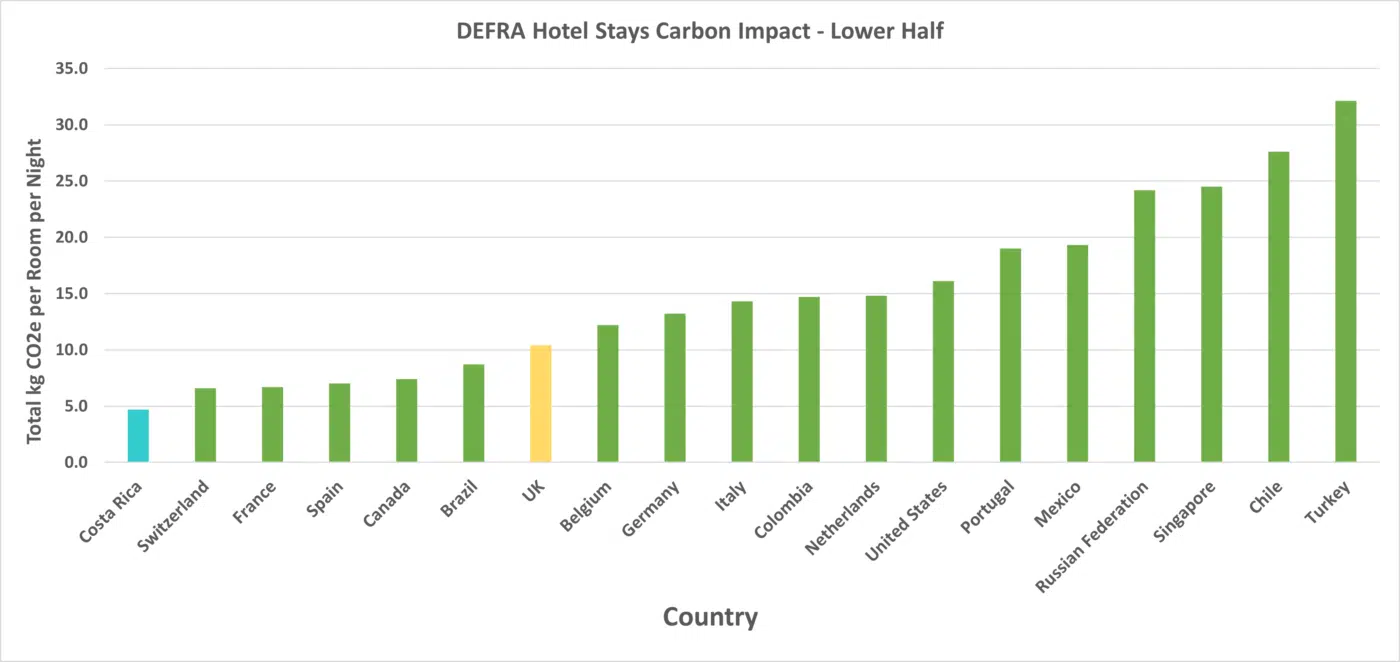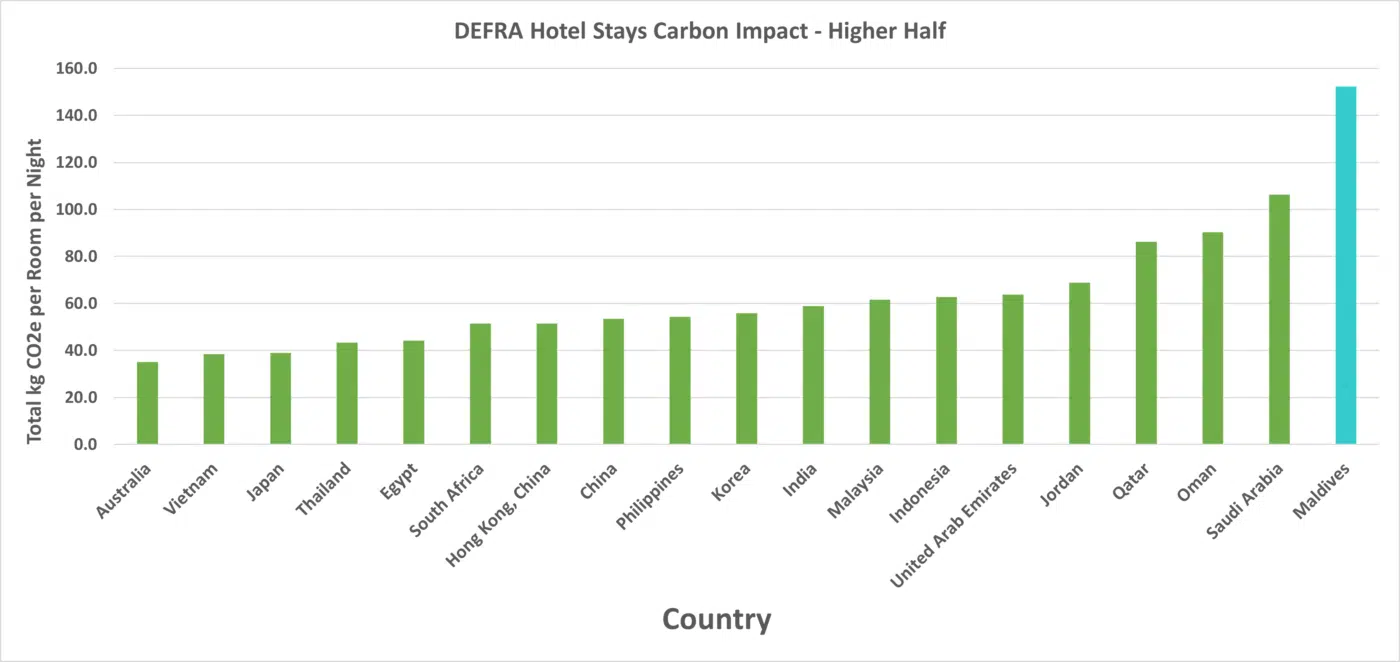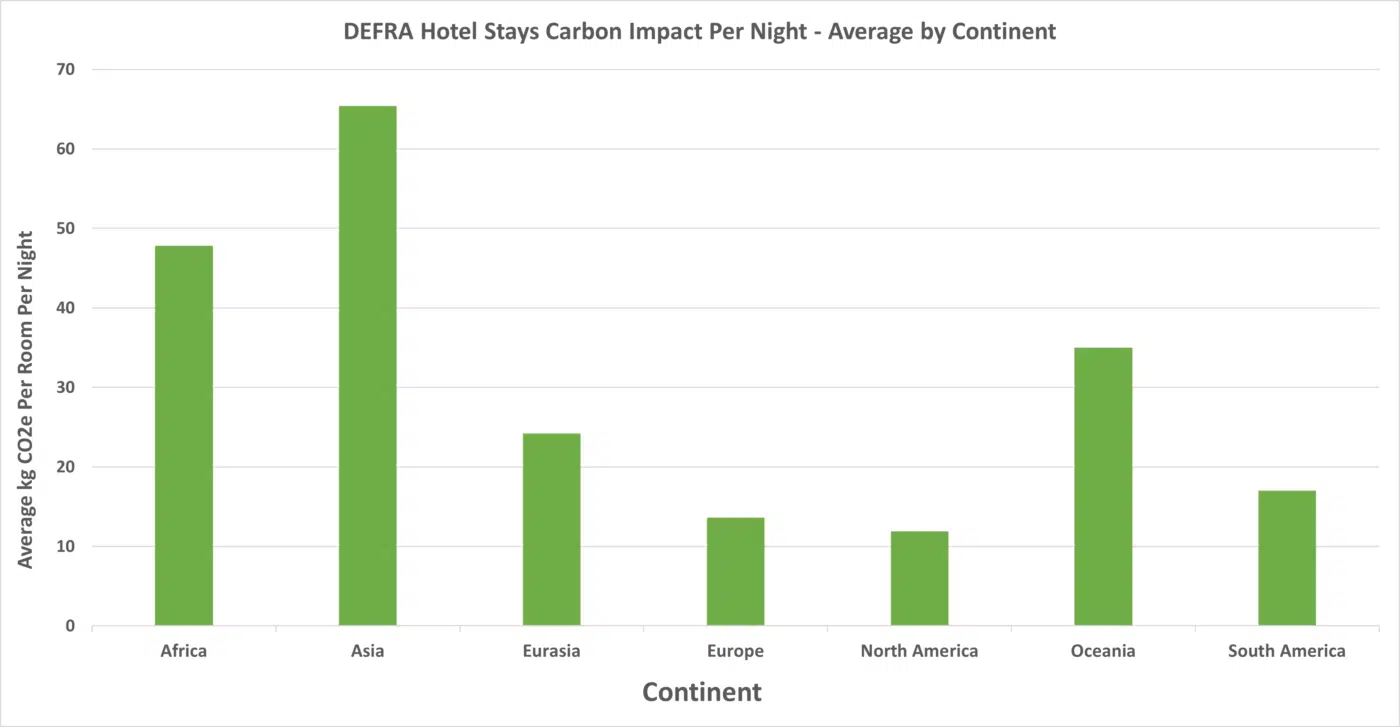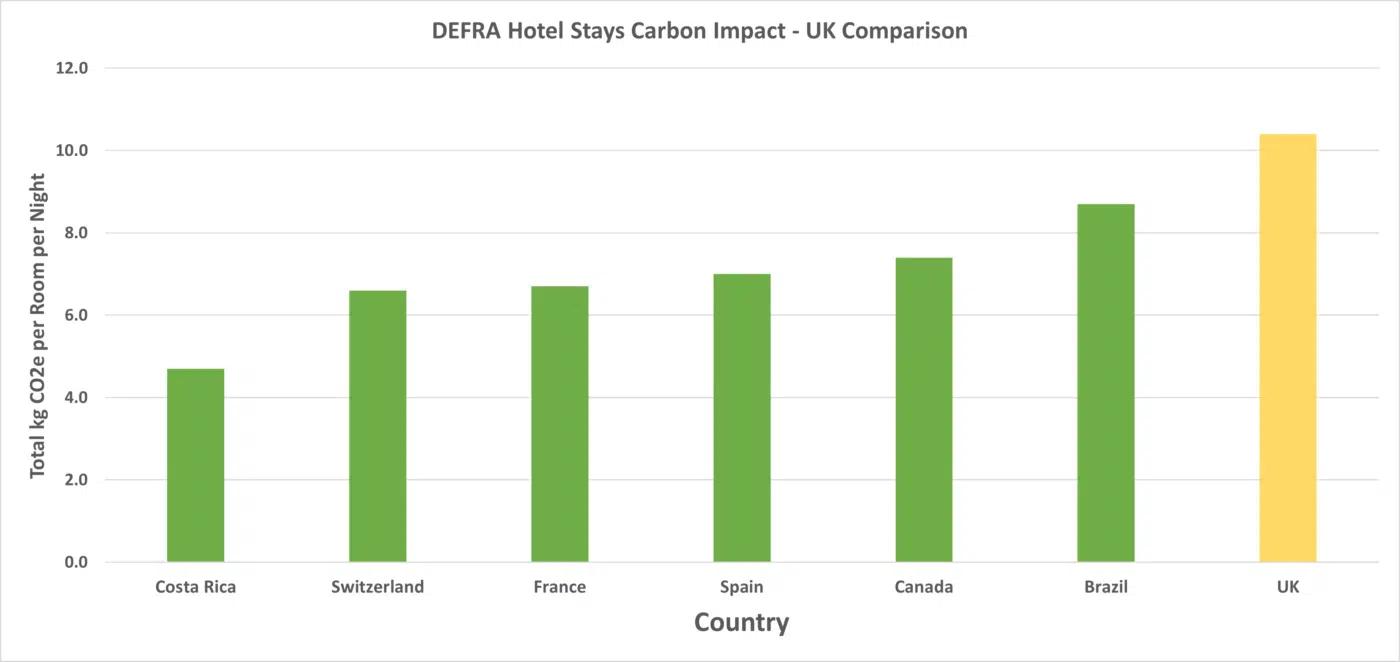Carbon Footprint, Sustainability
The Carbon Emissions of Staying in a Hotel
Have you ever wondered what the carbon emissions of staying in a hotel might be? In this article we’ll look at the differing impacts across multiple countries and continents.
Every year, the Department for Environment, Food & Rural Affairs (DEFRA) release its Greenhouse gas reporting: conversion factors. This comprehensive database of factors is widely used by UK and international organisations to report on greenhouse gas emissions. Within the 2022 dataset, conversion factors for international hotel stays are included for 38 countries. This allows for comparison of the carbon emissions of staying in a hotel across continents. Circular Ecology has done just this.
How are the Carbon Emissions Calculated?
The hotel conversion factors are taken from the Hotel Footprinting Tool which is produced by the International Tourism Partnership and Greenview . These factors have been derived from the Cornell Hotel Sustainability Benchmarking Index which uses annual data from international hotel companies. Further information, including data by city, can be found here.
Notes:
- Factors represent an average class of hotel and can be applied to any type of hotel
- Factors are calculated as an average for the specified country
Countries with the highest and lowest emission factors
The data set released in 2022 includes information for hotel stays in 38 different countries. The carbon impact of a night’s stay in each is shown in Figures 1 and 2.
Figure 1 – DEFRA Conversion Factors 2022 Hotel Stays (lower half)
Figure 2 – DEFRA Conversion Factors 2022 Hotel Stays (upper half)
The country with the highest carbon impact is the Maldives at 152.2 kg CO2e per hotel room per night. The lowest impact is Costa Rica at 4.7 kg CO2e per hotel room per night, a large difference of 147.5 kg CO2e. (Both shown in blue)
Additionally, Figure 2 shows that many of the countries with the highest impact hotel stays are located in Asia. Saudi Arabia, Oman and Qatar, for example show some of the highest impacts.
What influences the carbon emissions?
In the case of Costa Rica, most of the energy supply across the country is derived from renewables. According to the country’s National Centre for Energy Control, Costa Rica has been running on more than 98% renewable energy since 2014, with 67.5% of this coming from hydropower.
As a result, hotels in Costa Rica are using a low carbon energy mix resulting in the low carbon impact as seen in the DEFRA 2022 Conversion Factors.
In stark contrast, data from the International Renewable Energy Agency concluded that 99% of the total energy supply for the Maldives in 2019 came from oil (IRENA). Furthermore, the same report also shows that the Maldives imported 100% of its energy.
Interestingly, the report also details that there is significant capacity for solar and wind generation on the Maldives islands. However, the funding towards renewables has significantly declined since 2014. This indicates that although the Maldives has the potential to be more self-sufficient in terms of energy supply, it is perhaps still deemed more economically beneficial for them to import it for now.
Additionally, due to the size and remoteness of the islands, large amounts of resources are imported to the Maldives. Given that tourism is the largest sector of Maldives economy, it could be expected that a lot of imports are used for hotels and resorts. In fact in 2021, $2.57B worth of goods were imported (Statistica). This would undoubtedly contribute significantly to the carbon footprint of the hotels and resorts.
Average emissions by continent
Figure 3 shows the average emissions by continent. This again shows that hotels located in Asia have the highest average impact per room per night. The most complete information available is for Asia, with 17 of the 38 countries that make up the DEFRA data. A further 10 countries are European.
Figure 3 – DEFRA Conversion Factors 2022 Hotel Stays Average by Continent
At this time, there are very few countries represented from the other continents: two from Africa, four from North America, three from South America and one from Oceania. The small amount of data is a limitation and means the averages will not best represent the entire continent. Nevertheless, they offer interesting insight on the differences in hotel stay emissions across the world.
Staying in a hotel in the UK
According to DEFRA, the carbon emissions of staying in a hotel in the UK are 10.4 kg CO2e. (Per room per night).
How does this rank amongst the other available data? A figure of 10.4 kg CO2e per room per night ranks the UK a little outside the top five lowest impact hotel stays in 7th place. Overall, it is the 4th lowest footprint within the European countries where data is available. Only Switzerland, France and Spain outrank the UK.
Figure 4 shows the top five countries as well as the UK in yellow for comparison. Although the UK has one of the lower carbon emissions per room per night, there are still significant opportunities for further reductions by increasing our use of renewable energy.
Whilst Costa Rica has the advantage of consistent sunshine for its solar panels and France have a significant amount of nuclear power, they provide an example of where the UK would one day need to be.
Figure 4 – DEFRA Conversion Factors 2022 Hotel Stays UK Comparison
Summary
In conclusion, countries like the Maldives and Saudi Arabia, who both have a footprint of over 100 kg CO2e per room per night, have a lot to do to reduce the carbon emissions of their hotels. Outside influence may prove helpful in order to encourage countries to invest in low carbon technologies renewable energy facilities.
In addition to trying to reduce the impact of hotel stays, individuals should also make every effort to reduce their travel carbon footprint. Whilst the figures for many countries could be considerable for a 2-week holiday, with the added impact of any travel to be factored into the final decision, there are certainly countries that the carbon conscious traveller could visit while minimising concerns over their own personal carbon footprint. For example, travelling to France from the UK via the Eurostar would have a much lower carbon impact than flying. Added to the low impact per room per night in France, a great but lower carbon holiday can be enjoyed.
Try our quiz on the carbon impact of hotel stays below!
For more interesting sustainability articles, sign up to our monthly newsletter and follow us on LinkedIn!
Featured image provided royalty free from Pexels





